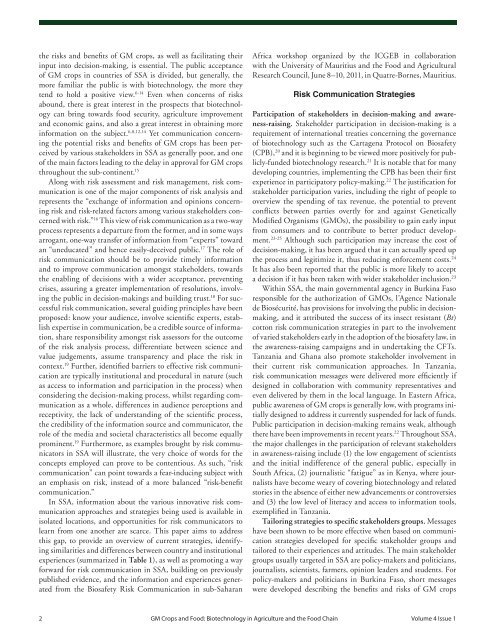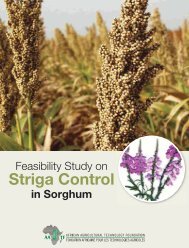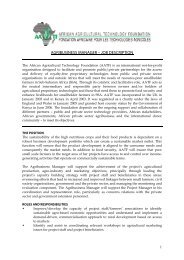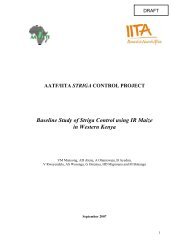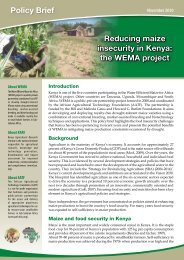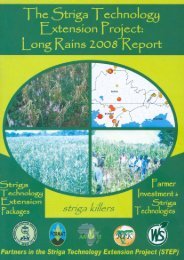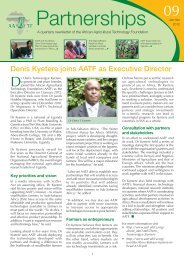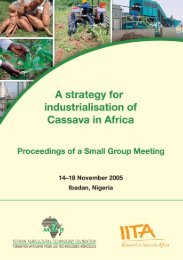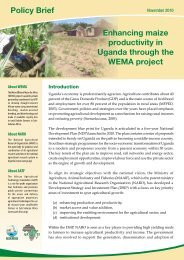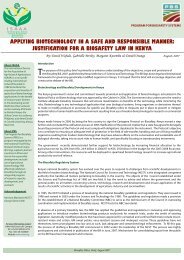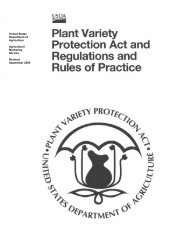Experiences in sub-Saharan Africa with GM crop risk communication
Experiences in sub-Saharan Africa with GM crop risk communication
Experiences in sub-Saharan Africa with GM crop risk communication
Create successful ePaper yourself
Turn your PDF publications into a flip-book with our unique Google optimized e-Paper software.
the <strong>risk</strong>s and benefits of <strong>GM</strong> <strong>crop</strong>s, as well as facilitat<strong>in</strong>g their<br />
<strong>in</strong>put <strong>in</strong>to decision-mak<strong>in</strong>g, is essential. The public acceptance<br />
of <strong>GM</strong> <strong>crop</strong>s <strong>in</strong> countries of SSA is divided, but generally, the<br />
more familiar the public is <strong>with</strong> biotechnology, the more they<br />
tend to hold a positive view. 6-14 Even when concerns of <strong>risk</strong>s<br />
abound, there is great <strong>in</strong>terest <strong>in</strong> the prospects that biotechnology<br />
can br<strong>in</strong>g towards food security, agriculture improvement<br />
and economic ga<strong>in</strong>s, and also a great <strong>in</strong>terest <strong>in</strong> obta<strong>in</strong><strong>in</strong>g more<br />
<strong>in</strong>formation on the <strong>sub</strong>ject. 6,8,12,14 Yet <strong>communication</strong> concern<strong>in</strong>g<br />
the potential <strong>risk</strong>s and benefits of <strong>GM</strong> <strong>crop</strong>s has been perceived<br />
by various stakeholders <strong>in</strong> SSA as generally poor, and one<br />
of the ma<strong>in</strong> factors lead<strong>in</strong>g to the delay <strong>in</strong> approval for <strong>GM</strong> <strong>crop</strong>s<br />
throughout the <strong>sub</strong>-cont<strong>in</strong>ent. 15<br />
Along <strong>with</strong> <strong>risk</strong> assessment and <strong>risk</strong> management, <strong>risk</strong> <strong>communication</strong><br />
is one of the major components of <strong>risk</strong> analysis and<br />
represents the “exchange of <strong>in</strong>formation and op<strong>in</strong>ions concern<strong>in</strong>g<br />
<strong>risk</strong> and <strong>risk</strong>-related factors among various stakeholders concerned<br />
<strong>with</strong> <strong>risk</strong>.” 16 This view of <strong>risk</strong> <strong>communication</strong> as a two-way<br />
process represents a departure from the former, and <strong>in</strong> some ways<br />
arrogant, one-way transfer of <strong>in</strong>formation from “experts” toward<br />
an “uneducated” and hence easily-deceived public. 17 The role of<br />
<strong>risk</strong> <strong>communication</strong> should be to provide timely <strong>in</strong>formation<br />
and to improve <strong>communication</strong> amongst stakeholders, towards<br />
the enabl<strong>in</strong>g of decisions <strong>with</strong> a wider acceptance, prevent<strong>in</strong>g<br />
crises, assur<strong>in</strong>g a greater implementation of resolutions, <strong>in</strong>volv<strong>in</strong>g<br />
the public <strong>in</strong> decision-mak<strong>in</strong>gs and build<strong>in</strong>g trust. 18 For successful<br />
<strong>risk</strong> <strong>communication</strong>, several guid<strong>in</strong>g pr<strong>in</strong>ciples have been<br />
proposed: know your audience, <strong>in</strong>volve scientific experts, establish<br />
expertise <strong>in</strong> <strong>communication</strong>, be a credible source of <strong>in</strong>formation,<br />
share responsibility amongst <strong>risk</strong> assessors for the outcome<br />
of the <strong>risk</strong> analysis process, differentiate between science and<br />
value judgements, assume transparency and place the <strong>risk</strong> <strong>in</strong><br />
context. 19 Further, identified barriers to effective <strong>risk</strong> <strong>communication</strong><br />
are typically <strong>in</strong>stitutional and procedural <strong>in</strong> nature (such<br />
as access to <strong>in</strong>formation and participation <strong>in</strong> the process) when<br />
consider<strong>in</strong>g the decision-mak<strong>in</strong>g process, whilst regard<strong>in</strong>g <strong>communication</strong><br />
as a whole, differences <strong>in</strong> audience perceptions and<br />
receptivity, the lack of understand<strong>in</strong>g of the scientific process,<br />
the credibility of the <strong>in</strong>formation source and communicator, the<br />
role of the media and societal characteristics all become equally<br />
prom<strong>in</strong>ent. 19 Furthermore, as examples brought by <strong>risk</strong> communicators<br />
<strong>in</strong> SSA will illustrate, the very choice of words for the<br />
concepts employed can prove to be contentious. As such, “<strong>risk</strong><br />
<strong>communication</strong>” can po<strong>in</strong>t towards a fear-<strong>in</strong>duc<strong>in</strong>g <strong>sub</strong>ject <strong>with</strong><br />
an emphasis on <strong>risk</strong>, <strong>in</strong>stead of a more balanced “<strong>risk</strong>-benefit<br />
<strong>communication</strong>.”<br />
In SSA, <strong>in</strong>formation about the various <strong>in</strong>novative <strong>risk</strong> <strong>communication</strong><br />
approaches and strategies be<strong>in</strong>g used is available <strong>in</strong><br />
isolated locations, and opportunities for <strong>risk</strong> communicators to<br />
learn from one another are scarce. This paper aims to address<br />
this gap, to provide an overview of current strategies, identify<strong>in</strong>g<br />
similarities and differences between country and <strong>in</strong>stitutional<br />
experiences (summarized <strong>in</strong> Table 1), as well as promot<strong>in</strong>g a way<br />
forward for <strong>risk</strong> <strong>communication</strong> <strong>in</strong> SSA, build<strong>in</strong>g on previously<br />
published evidence, and the <strong>in</strong>formation and experiences generated<br />
from the Biosafety Risk Communication <strong>in</strong> <strong>sub</strong>-<strong>Saharan</strong><br />
<strong>Africa</strong> workshop organized by the ICGEB <strong>in</strong> collaboration<br />
<strong>with</strong> the University of Mauritius and the Food and Agricultural<br />
Research Council, June 8–10, 2011, <strong>in</strong> Quatre-Bornes, Mauritius.<br />
Risk Communication Strategies<br />
Participation of stakeholders <strong>in</strong> decision-mak<strong>in</strong>g and awareness-rais<strong>in</strong>g.<br />
Stakeholder participation <strong>in</strong> decision-mak<strong>in</strong>g is a<br />
requirement of <strong>in</strong>ternational treaties concern<strong>in</strong>g the governance<br />
of biotechnology such as the Cartagena Protocol on Biosafety<br />
(CPB), 20 and it is beg<strong>in</strong>n<strong>in</strong>g to be viewed more positively for publicly-funded<br />
biotechnology research. 21 It is notable that for many<br />
develop<strong>in</strong>g countries, implement<strong>in</strong>g the CPB has been their first<br />
experience <strong>in</strong> participatory policy-mak<strong>in</strong>g. 22 The justification for<br />
stakeholder participation varies, <strong>in</strong>clud<strong>in</strong>g the right of people to<br />
overview the spend<strong>in</strong>g of tax revenue, the potential to prevent<br />
conflicts between parties overtly for and aga<strong>in</strong>st Genetically<br />
Modified Organisms (<strong>GM</strong>Os), the possibility to ga<strong>in</strong> early <strong>in</strong>put<br />
from consumers and to contribute to better product development.<br />
23-25 Although such participation may <strong>in</strong>crease the cost of<br />
decision-mak<strong>in</strong>g, it has been argued that it can actually speed up<br />
the process and legitimize it, thus reduc<strong>in</strong>g enforcement costs. 24<br />
It has also been reported that the public is more likely to accept<br />
a decision if it has been taken <strong>with</strong> wider stakeholder <strong>in</strong>clusion. 23<br />
With<strong>in</strong> SSA, the ma<strong>in</strong> governmental agency <strong>in</strong> Burk<strong>in</strong>a Faso<br />
responsible for the authorization of <strong>GM</strong>Os, l’Agence Nationale<br />
de Biosécurité, has provisions for <strong>in</strong>volv<strong>in</strong>g the public <strong>in</strong> decisionmak<strong>in</strong>g,<br />
and it attributed the success of its <strong>in</strong>sect resistant (Bt)<br />
cotton <strong>risk</strong> <strong>communication</strong> strategies <strong>in</strong> part to the <strong>in</strong>volvement<br />
of varied stakeholders early <strong>in</strong> the adoption of the biosafety law, <strong>in</strong><br />
the awareness-rais<strong>in</strong>g campaigns and <strong>in</strong> undertak<strong>in</strong>g the CFTs.<br />
Tanzania and Ghana also promote stakeholder <strong>in</strong>volvement <strong>in</strong><br />
their current <strong>risk</strong> <strong>communication</strong> approaches. In Tanzania,<br />
<strong>risk</strong> <strong>communication</strong> messages were delivered more efficiently if<br />
designed <strong>in</strong> collaboration <strong>with</strong> community representatives and<br />
even delivered by them <strong>in</strong> the local language. In Eastern <strong>Africa</strong>,<br />
public awareness of <strong>GM</strong> <strong>crop</strong>s is generally low, <strong>with</strong> programs <strong>in</strong>itially<br />
designed to address it currently suspended for lack of funds.<br />
Public participation <strong>in</strong> decision-mak<strong>in</strong>g rema<strong>in</strong>s weak, although<br />
there have been improvements <strong>in</strong> recent years. 22 Throughout SSA,<br />
the major challenges <strong>in</strong> the participation of relevant stakeholders<br />
<strong>in</strong> awareness-rais<strong>in</strong>g <strong>in</strong>clude (1) the low engagement of scientists<br />
and the <strong>in</strong>itial <strong>in</strong>difference of the general public, especially <strong>in</strong><br />
South <strong>Africa</strong>, (2) journalistic “fatigue” as <strong>in</strong> Kenya, where journalists<br />
have become weary of cover<strong>in</strong>g biotechnology and related<br />
stories <strong>in</strong> the absence of either new advancements or controversies<br />
and (3) the low level of literacy and access to <strong>in</strong>formation tools,<br />
exemplified <strong>in</strong> Tanzania.<br />
Tailor<strong>in</strong>g strategies to specific stakeholders groups. Messages<br />
have been shown to be more effective when based on <strong>communication</strong><br />
strategies developed for specific stakeholder groups and<br />
tailored to their experiences and attitudes. The ma<strong>in</strong> stakeholder<br />
groups usually targeted <strong>in</strong> SSA are policy-makers and politicians,<br />
journalists, scientists, farmers, op<strong>in</strong>ion leaders and students. For<br />
policy-makers and politicians <strong>in</strong> Burk<strong>in</strong>a Faso, short messages<br />
were developed describ<strong>in</strong>g the benefits and <strong>risk</strong>s of <strong>GM</strong> <strong>crop</strong>s<br />
2 <strong>GM</strong> Crops and Food: Biotechnology <strong>in</strong> Agriculture and the Food Cha<strong>in</strong> Volume 4 Issue 1


